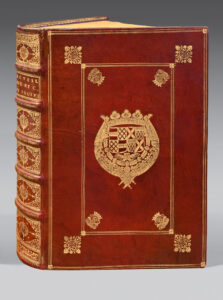Paris, Frederic Leonard, 1686.
4to of (1) bl.l., (4) ll., 687 pp., xlviii pp. (Liste des temples de la religion P.R. Abbatus depuis le règne de Louis le Grand). Followed by : – Recueil de ce qui s’est fait en France de plus considérable, contre les protestans, depuis la revocation de l’Edit de Nantes. Avec une préface, pour justifier la conduite qu’on a tenue dans ce Royaume, pour porter les Pretendus Reformes à se réunir à l’Eglise.
Paris, Frederic Leonard, 1686. (1) l., xcvi pp. then 47 pp. for part 4.
Red morocco, double frame with triple gilt fillets à la Duseuil with gilt fleurons and monograms at corners, large gilt coat of arms in the center of the covers, richly decorated ribbed spine, gilt edges, very slight splitting at spines, slight dark stains on upper cover. Contemporary armorial binding.
253 x 182 mm.
First edition of this important work on the consequences for protestants of the revocation of the Edict of Nantes.
Copy in which were bound the Ordonnances contre les nouveaux catholiques qui refuseront les sacremens.
“This interesting work contains a ‘Catalogue des livres condamnés par l’Archev. de Paris’ on page 325 and following » (Jacob, Catalogue des livres anciens rares et curieux, 1445).
Jacques Lefèvre, French controversialist, born in Lisieux in the mid-seventeenth century, died in Paris on July 1, 1716. Having embraced the ecclesiastical state, he became archdeacon of his native town, and grand vicar to the archbishop of Bourges. After receiving his doctorate from the Sorbonne in 1674, he was imprisoned in the Bastille for a lively polemic against Father Maimbourg in the same year, which led to his being called Lefèvre de la Bastille. He died in Paris on July 1, 1716.
A superb copy of this rare work in a spectacular contemporary binding with a prestigious, rare and interesting provenance: the arms and figures C (Charles) and I (Julie) of the duke and duchesse de Montausier.
Charles de Sainte-Maure de Montausier (1610-1690), governor of the Grand Dauphin (from 1668), raised in the Reformed religion (which he renounced in 1645), was renowned for his feats of arms (maréchal de camp des armées du roi then governor of Haute-Alsace, Saintonge and Angoumois at age 27) and his passion for the precious Julie d’Angennes (1607-1671).
Eldest daughter of the Marquis de Rambouillet and Catherine de Vivonnes, the “Incomparable Julie”, celebrated for her wit, beauty and generosity, made her suitor languish for 14 years before granting her hand in marriage in 1645. The latter had conceived a collection of sixteen madrigals to the glory of his beloved, “La Guirlande de Julie”, written by some of the most important authors of the time (G. de Scudéry, Tallemant des Réaux, Conrart, probably Corneille, etc.), who also frequented the Hôtel de Rambouillet. The superb manuscript, handwritten on vellum by Nicolas Jarry, decorated with flowers painted by Nicolas Robert, and bound in red morocco by Le Gascon, is now kept in the manuscript department of the Bibliothèque nationale de France. After becoming governess to the Grande Dauphine and then Dame d’Honneur to Queen Marie-Thérèse, she worked to promote Louis XIV’s love affairs with Mademoiselle de La Vallière and Madame de Montespan, and had to leave the court when the latter fell out of favor in 1669. Baron de Montausier is said to have served as Molière’s model for Le Misanthrope.
The volumes stamped with this tool and accompanied by the monogram “CCII” can be attributed to both the Duchesse de Montausier and her husband, Charles de Sainte-Maure (O.H.R. 451 tools 1 and 3).
See less information

![Nouveau recueil de tout ce qui s’est fait pour et contre les protestans, particulièrement en France où l’on voit l’establissement, le Progres, la Décadence, & l’Extinction de la R.P.R. dans ce Royaume. [Deuxième… Troisième… Quatrième… parties].](https://www.camillesourget.com/wp-content/uploads/2024/06/Reliure-tranche-doree-scaled.jpg)
![Nouveau recueil de tout ce qui s’est fait pour et contre les protestans, particulièrement en France où l’on voit l’establissement, le Progres, la Décadence, & l’Extinction de la R.P.R. dans ce Royaume. [Deuxième… Troisième… Quatrième… parties]. - Image 2](https://www.camillesourget.com/wp-content/uploads/2024/06/Titre-9-scaled.jpg)
